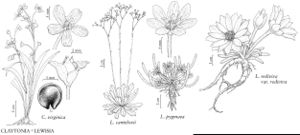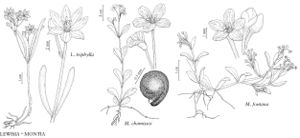Lewisia
Fl. Amer. Sept. 2: 360. 1814.
Herbs, perennial, with enlarged caudices. Roots taproots, gradually ramified distally or fusiform to napiform, rarely globose and cormlike, fleshy. Stems deciduous, prostrate to erect, scapelike, simple or branched; nodes glabrous. Leaves basal or basal and cauline; basal leaves evergreen or ephemeral, in basal rosettes or tufts (except in L. triphylla); cauline leaves, if present, alternate, opposite, or whorled, ± sessile or gradually or abruptly narrowed basally into broad, clasping petiole; blade fleshy, margins entire, toothed, or crisped, often hyaline near base. Inflorescences racemose, paniculate, or subumbellate cymes, pedunculate, or with flowers borne singly; bracts persistent, 2 (–9) at each flowering node, subequal, margins entire, toothed, or glandular-toothed, herbaceous or scarious. Flowers pedicellate or sessile, persistent or disarticulate in fruit; sepals persistent, 2 (–9), equal or subequal when paired, margins entire, toothed, or glandular-toothed, herbaceous or scarious; petals (4–) 5–10 (–19), twisting about and falling away with capsules after anthesis; stamens 1–50, distinct to scarcely connate and/or adnate to petals basally; ovules 1–50; style branched; stigmas 2–8. Capsules dehiscence circumscissile near base, splitting from base toward apex. Seeds 1–50, brown or black, smooth or minutely sculpted, estrophiolate. x = 10, 11, 12, 13, 14, 15.
Distribution
w North America (including Mexico)
Discussion
Species 16 (16 in the flora).
The number and circumscription of species in Lewisia are not widely agreed upon because of morphological variability and intergradation. Natural hybridization is inferred for some plants. In cultivation, the species reputedly freely intercross; most hybrid offspring are sterile. Most species are cultivated by alpine/succulent plant enthusiasts. In the wild, the plants usually occur in small, isolated populations in rocky or gravelly places, especially in canyons or alpine flats.
The key to species here has been modified from B. Mathew (1989b). Hybrids, cultivars, and plants in cultivation may not key satisfactorily.
Selected References
Lower Taxa
Key
| 1 | Roots globose, cormlike; basal leaves usually senescent before anthesis; cauline leaves in single pair or whorl of 3(-5) | Lewisia triphylla |
| 1 | Roots elongate, gradually ramified distally, or fusiform to napiform; basal leaves evergreen or senescent at or immediately following anthesis; cauline leaves in more than 1 opposite pair or alternate, or absent | > 2 |
| 2 | Basal leaves evergreen | > 3 |
| 2 | Basal leaves senescing at or soon after anthesis | > 6 |
| 3 | Basal leaf blades linear to narrowly oblanceolate, margins entire | > 4 |
| 3 | Basal leaf blades oblanceolate, spatulate, obovate, orbiculate, or very rarely nearly linear, margins entire or toothed | > 5 |
| 4 | Leaves ± terete | Lewisia leeana |
| 4 | Leaves flattened or adaxial surface grooved | Lewisia columbiana |
| 5 | Petals 5-9 mm, white to pale pink with darker veins; cymes loosely paniculate | Lewisia cantelovii |
| 5 | Petals (8-)10-20 mm, usually pink-purple with pale and darker stripes, less often white, cream with pink-orange stripes, ± orange, or yellow; cymes densely paniculate to subumbellate | Lewisia cotyledon |
| 6 | Flowers sessile; bract and sepal pairs decussate and appearing to form 4-merous calyx | > 7 |
| 6 | Flowers pedicellate; bracts and sepals not resembling 4-merous calyx | > 8 |
| 7 | Sepal margins toothed, sometimes glandular; petals 10-15 mm | Lewisia kelloggii |
| 7 | Sepal margins entire, not glandular; petals 12-26 mm | Lewisia brachycalyx |
| 8 | Flowers disarticulate in fruit; sepals 2-9, scarious at anthesis, margins entire to somewhat erose, not toothed | > 9 |
| 8 | Flowers not disarticulate in fruit; sepals 2, herbaceous at anthesis, margins entire, toothed, or glandular-toothed | > 11 |
| 9 | Sepals (4-)6-9; petals 10-19; proximalmost bracts in whorl of 4-7(-8) | Lewisia rediviva |
| 9 | Sepals 2-4; petals 5-9; proximal bracts in 1 pair or whorl of 3-4 | > 10 |
| 10 | Sepals 2; petals 5-8; bracts ovate to lanceolate; flowers borne singly; s Sierra Nevada, California | Lewisia disepala |
| 10 | Sepals 3-4; petals 7-9; bracts oblong to oblong-ovate; inflorescences 2-3-flowered or flowers borne singly; Nye County, Nevada | Lewisia maguirei |
| 11 | Cauline leaves opposite, in 1-3 pairs, not markedly smaller than basal leaves | Lewisia oppositifolia |
| 11 | Cauline leaves absent or alternate, markedly smaller than basal leaves | > 12 |
| 12 | Basal leaf blades oblanceolate, spatulate, or obovate; inflorescences paniculate or subumbellate cymes, 3-100-flowered | > 13 |
| 12 | Basal leaf blades linear to linear-oblanceolate; inflorescences 2-7-flowered racemose cymes or flowers borne singly | > 14 |
| 13 | Inflorescences 3-7-branched paniculate cymes, 20-100-flowered; petals 6-7, pale pink with yellow-green bases; stamens 4-5; Mari- posa County, California | Lewisia congdonii |
| 13 | Inflorescences 1-3-branched subumbellate cymes, 3-11-flowered; petals 7-10, magenta or carmine with whitish bases; stamens 10-13; n Coast Ranges, California | Lewisia stebbinsii |
| 14 | Flowers 2.5-4 cm diam.; Eldorado County, Nevada, and Placer County, California | Lewisia longipetala |
| 14 | Flowers 0.5-2 cm diam.; more widely distributed | > 15 |
| 15 | Sepal margins mostly entire, sometimes obscurely or irregularly toothed, not glan- dular, apex acute to subacute; taproot napiform to shortly fusiform | Lewisia nevadensis |
| 15 | Sepal margins regularly toothed, usually glandular-toothed (rarely ± entire), apex truncate or sometimes rounded, obtuse, subacute, or apiculate; taproot gradually ramified distally or shortly fusiform, rarely subnapiform | Lewisia pygmaea |
"broad" is not a number.

